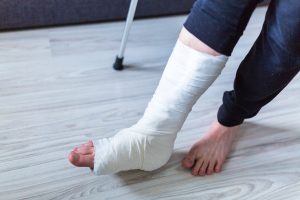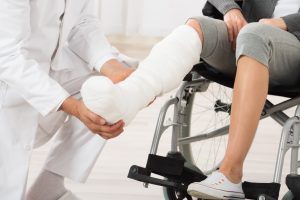This guide discusses when you could be eligible to make an accident at work claim for leg injury at work compensation. All employers owe their employees a duty of care. We will explain what this duty is and the eligibility criteria your case must meet in order to have a valid claim.
Following this, we will provide examples of workplace accidents that could potentially lead to leg injury compensation claims. We will then discuss how your leg injury claim may be calculated and the different forms of compensation you could be awarded.
Gathering evidence is a crucial step in the claiming process, so this guide provides you with some examples of the evidence you could gather to support your case. The final section of this guide explains how a personal injury solicitor from our panel may be able to assist you with your claim by offering their services on a No Win No Fee basis.
If you have any questions regarding leg injury claims, or would like to discuss the eligibility of your particular case, you can contact our team of advisors. You can reach them via the following contact methods:
- Call 020 8050 2736
- Complete our ‘claim online‘ form to organise a callback.
- Speak with an advisor using the live chat pop-up.

Choose A Section
- When Could You Claim Leg Injury At Work Compensation?
- What Are Common Accidents That Could Lead To A Leg Injury At Work?
- How Much Leg Injury At Work Compensation Could You Receive?
- What Evidence Could Help You Make A Leg Injury Compensation Claim?
- What Are The Benefits Of Using A No Win No Fee Solicitor?
- Read More About Claiming Leg Injury At Work Compensation
When Could You Claim Leg Injury At Work Compensation?
The Health and Safety at Work etc. Act 1974 (HASAWA) describes the duty of care that employers have towards their employees. They need to take steps that are both reasonable and practicable to protect the well-being and safety of their employees whilst working.
Some steps the employer can take to meet this duty include:
- Carrying out regular risk assessments and addressing any hazards they come across.
- Ensuring all staff have received relevant and appropriate training to complete their work duties, such as manual handling training.
- Making sure that all tools and equipment are safe, fit for purpose and regularly maintained.
Failure to carry out their duty of care could result in you suffering an injury at work. However, to be eligible to claim leg injury compensation, you will need to show you meet the personal injury claiming criteria. This is:
- Your employer had a care duty when the accident happened.
- This duty was breached.
- Because of this, you suffered a leg injury.
What Are Common Types Of Leg Injuries?
There are various types of leg injuries that you could suffer in an accident at work. Some examples could include:
- Fractures to the femur.
- Tibia or fibula fractures.
- Sprains and strains.
- Soft-tissue injuries.
- Cuts and lacerations.
- In severe cases, amputations.
To see whether you may have a valid leg injury at work compensation claim, you can contact one of the advisors on our team. They can also offer you free advice for your case.
What Are Common Accidents That Could Lead To A Leg Injury At Work?
There are also various different types of workplace accidents that could lead you to suffer a leg injury. However, to be able to claim compensation for your injury, your employer must have been liable due tot hem breaching their duty of care.
Some examples of accidents at work that could lead to you suffering a leg injury include:
- Despite knowing that you have received no training on how to operate one, your employer still asks you to use a forklift. You lose control of the forklift and crash into a wall, suffering a broken leg.
- Your employer provided you with a ladder that was known to be faulty. This causes you to fall from a height when the ladder breaks as you are using it. This causes you to suffer multiple injuries, such as a severe head injury and multiple leg fractures.
- Your employer failed to secure down or signpost some loose cable wires. This causes you to trip over them and suffer a knee injury.
To discuss your potential leg injury at work compensation claim, you can contact one of the advisors on our team. If they deem you to have a valid case, they may also connect you with one of the personal injury solicitors on our panel.
How Much Leg Injury At Work Compensation Could You Receive?
Provided that you have a valid leg injury at work compensation claim, you may be wondering how much compensation you could be eligible to receive.
If your claim is a success, as part of your compensation settlement, you will be awarded general damages. This compensates you for any physical and mental injuries you have suffered.
Potential Compensation For A Leg Amputation
Those responsible for calculating your claim for general damages could refer to the compensation guidelines provided by the Judicial College. They provide compensation guideline brackets for a range of different injuries.
We have used some of these entries regarding leg amputations for the table below. Please note that these should only be used as a guide and that the first entry has not been taken from the Judicial College.
| Type of Injury | Severity | Award Brackets | Notes |
|---|---|---|---|
| Multiple Serious Injuries With Financial Damage. | Serious | Up to £1,000,000+ | This amount would reflect several serious injuries and the resulting financial damage caused by inability to work and professional care costs. |
| Amputations | (i) Loss of Both Legs | £240,790 to £282,010 | Cases where both legs are lost above knee, or one leg is lost above the knee, with the other is below knee. Factors that determine the award include prevalence of d by phantom pains, psychological issues and degree of success with prosthetics as well as future hip and spine problems. |
| (ii) Below Knee Amputation of Both Legs | £201,490 to £270,100 | The award is guided by factors such as psychological problems, phantom pains and the success of any prosthetics. | |
| (iii) Above Knee Amputation of One Leg | £104,830 to £137,470 | The award will be based on the level of the amputation, severity of phantom pains, associated psychological problems and the person's ability to adapt to prosthetics. | |
| (iv) Below Knee Amputation of One Leg | £97,980 to £132,990 | Straightforward cases of below-knee amputation without complications attract awards at the lower end of this bracket. |
Potential Compensation For Other Leg Injuries
This table looks at compensation guidelines from the Judicial College for other types of leg injuries. Please note, once again, that the first entry has not been taken from the Judicial College.
| Area of Injury | Severity | Notes | Award Guidelines |
|---|---|---|---|
| Multiple Severe Injuries and Special Damages | Severe | This amount reflects multiple severe injuries and the financial losses and expense they create such as loss of earnings, care costs and travel expenses. | Up to £500,000+ |
| Legs | Severe (i) The Most Serious Injuries Short of Amputation | Injuries that are deemed as severe as amputation, such as extensive degloving or gross shortening of the leg. | £96,250 to £135,920 |
| Severe (ii) Very Serious | Injuries that cause mobility problems that are permanent and require the use of crutches and walking aids for the rest of the persons life. | £54,830 to £87,890 | |
| Severe (iii) Serious | Serious cases of compound or comminuted fractures to the joints or cases of ligament damage that requires a prolonged treatment period. | £39,200 to £54,830 | |
| Severe (iv) Moderate | Here are cases of complicated or multiple fractures as well as severe crushing injuries affecting one limb. | £27,760 to £39,200 | |
| Less Serious (i) Fractures from which an Incomplete Recovery is Made or Serious Soft Tissue Injuries | Here, the injured person makes a reasonable recovery but is left with a limp and suffers sensory loss and discomfort. | 17,960 to £27,760 | |
| Less Serious (ii) Simple Fractures | Cases of a simple fracture of a femur with no damage seen to any articular surfaces | £9,110 to £14,080 | |
| Less Serious (iii) Simple Tibia or Fibula Fractures or Soft Tissue Injuries | Awards at the top of this bracket reflect simple tibia or fibula fractures with minor persisting issues like restricted movement and dull aching. | Up to £11,840 |
Special Damages
A second head of loss called special damages could also form your final settlement. This reimburses you for any monetary losses or expenses you suffered because of the leg injury. This could include:
- Loss of past or future earnings.
- Medical costs such as physiotherapy or prescription fees.
- The cost to adapt your home or vehicle.
- Domestic care costs for anyone who helped look after you.
- Travel costs to appointments.
To include special damages in your claim, you will need to present documented evidence of these losses, such as invoices, payslips and receipts.
Contact our advisors today to receive a free valuation of your potential keg injury at work compensation claim.
What Evidence Could Help You Make A Leg Injury Compensation Claim?
Gathering evidence is a crucial step in the leg injury claims process. The evidence you collect needs to show how the accident occurred, how your employer was liable, and the injuries suffered. This could include, but is not limited to:
- CCTV footage that shows the accident taking place.
- Copies of your medical records or any X-rays that show the type of leg injury you suffered.
- Pictures of your visible injuries and the site where they happened.
- The contact information of anyone who witnessed the accident so they can provide a statement at a later date.
- A copy of your accident report in the workplace accident book.
If you decide to work with a solicitor on your case, as part of their services, they could help you with gathering this and any additional evidence to help support your claim.
How Long Do You Have To Make A Leg Injury Claim?
You may also be thinking, ‘How long do I have to claim after an accident at work?’ There is normally a three-year time limit for starting a personal injury claim. This time limit is set out under the Limitation Act 1980.
There are also exceptions to this rule. This applies to:
- Those injured as a minor (under the age of 18).
- Those who lack the mental capability to handle their own claim.
To discuss the personal injury claims time limit and the exceptions that apply, you can contact a member of our advisory team.
What Are The Benefits Of Using A No Win No Fee Solicitor?
Provided that your case meets the relevant claiming criteria, one of the solicitors on our panel could help you with making a leg injury at work compensation claim. Additionally, the solicitors on our panel usually offer their services to their clients through a Conditional Fee Agreement.
Some benefits of making a claim under this No Win No Fee arrangement include:
- No upfront fees to pay for the solicitor’s services.
- No service fees to pay while the claim moves forward.
- Should your broken leg claim fail, there are no fees to pay for the work your solicitor has provided.
A positive claim outcome requires a success fee to be paid to your solicitor. This fee is a percentage of your compensation. However, this percentage is subject to a legal limit and ensures you get to retain the bulk of the compensation awarded.
Contact Us
If you still have any questions regarding the personal injury claims process, you can contact a member of our advisory team. As well as answering your questions, they can offer you free advice for your leg injury at work compensation claim.
Speak with our team today using one of the following contact methods:
- Call 020 8050 2736
- Complete our ‘claim online‘ form to organise a callback.
- Chat with an advisor using the live chat pop-up.
Read More About Claiming Leg Injury At Work Compensation
Thank you for reading our guide. You might find these other accident at work claims guides helpful:
- Here we look at claiming compensation if you are injured by a moving object at work.
- Advice for claiming if you were injured in a slip, trip and fall at work.
- Guidance regarding the most common causes of injuries at work and how they could lead to personal injury claims.
You can also find some helpful external links below:
- Guidance on when to call 999 from the NHS.
- Statics of non-fatal workplace accidents in Britain from the Health and Safety Executive (HSE).
- Here is guidance about claiming statutory sick pay (SSP) from Gov.UK.
To discuss your leg injury at work compensation claim and receive free advice, you can contact our team of advisors.



